
The Serious Freshening
Go to <Last, Summary, Next>Engine—Paint Engine
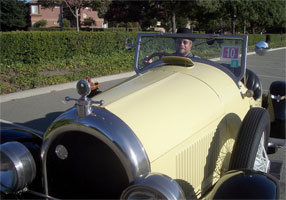 Lynn in Bugsby, September 5, 2005 |
Revised: 2006-08-15 — Started: 2006-02-18
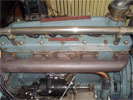 |
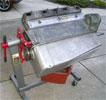 |
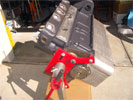 |
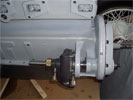 |
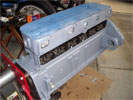 |
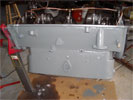 |
| ENGINE PAINT: The engine paint on the car as delivered to Lynn could not take the heat from the exhaust manifold (top left). After stripping the old paint (top center), Lynn refinishes the engine using a 1200°F paint (top right) to try and avoid this problem in the future. However, it takes Lynn one more complete stripping and three different color coats (bottom row) to get the results that he wants (bottom right). |
 |
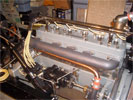 |
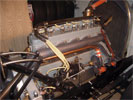 |
| FINAL RESULT: Comparing the colors that Lynn used side-by-side (left, painted on an iron leaf spring) better shows the differences in shade. The resulting assembled engine installed in the chassis is also shown (center, right). |
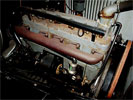 |
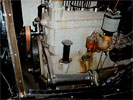 |
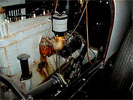 |
| A MUSEUM CAR: Here are three shots by Dale Anderson of a 1925 Model 6-55 Kissel engine in the Wisconsin Automotive Museum. One should be cautious in a direct comparison of Lynn's photos of Bugsby with these pictures from the museum, as they were taken at different times with different cameras under different lighting conditions. Also, the paint on the museum car is considerably weathered. The best that Lynn can say at this point is that he's willing to accept NEW FORD GRAY as a reasonable approximation for Kissel engine gray. |
Work Completed:
After stripping the old paint, Lynn refinishes Bugsby's engine using cast-iron-gray
AREMCO 1200°F Pyro-Paint™ that he obtained
from Restoration Supply Company.
Lynn specifically got this high-temperature paint in an attempt to avoid the damage to the previous engine
paint that he observed around the exhaust manifold.
While Lynn really likes the finish and durability of the AREMCO Pyro-Paint, the color does not match the color of Kissel engines that he's seen in several photos. As Lynn is serious about trying to do a historically creditable job refreshing Bugsby, he feels that he needs to do a better job on the engine paint.
Lynn searches the internet for weeks trying to discover the correct Kissel engine color, but he doesn't find any good guidance. He also can't locate a good source for a high-temperature, lighter gray brush-on engine paint. Finally he purchases several spray cans of VHT (Very High Temperature) FlameProof header paint. This stuff is rated at 1300-2000°F (700-1100°C)! Spraying over his existing AREMCO Pyro-Paint finish, Lynn applies the VHT paint.
Lynn hates it! The paint isn't durable (easily scratches and rubs off) and the gray is too light and readily shows his greasy fingerprints as Lynn works on the engine. (In fairness to VHT, maybe the paint needs to cure at temperature before it gets really hard.)
For his third attempt, Lynn purchases some generic white pigment and mixes it with his AREMCO Pyro-Paint (1:10) to get a medium gray that he feels is an appropriate color for his Kissel engine. Since the engine already has two coats of paint, he strips the engine a second time before applying his new custom paint. Lynn is temporarily satisfied with this third attempt.
Unwilling to let well enough alone, Lynn starts asking other Kissel owners if they know what the official factory engine color is. Don Bosco, owner of a 1923 6-55 Speedster and a 1925 6-55 2-Door Brougham tells Lynn via email that he's matched the engine paint to New Ford Gray (Plasti-Kote Engine Enamel No 216). This match came from a protected area under the front motor mount on Don's Speedster engine which had never been taken apart before Don made his color match.
Lynn makes a beeline to his local auto parts stores (he visits three) looking for Plasti-Kote paints. Apparently in Livermore, the stores only stock the Dupli-Color paint line, but Lynn finds plenty of the New Ford Gray engine paint (Dupli-Color Engine Enamel DE1611). Lynn buys a can and brings it home.
Hoping against hope, Lynn compares the New Ford Gray against his third engine paint job. Lynn spends an agonizing hour trying to rationalize to himself why he shouldn't paint his engine yet again (a fourth time). But he's invested too much time, energy and expense already to step away from this with open issues. Also he's haunted by the ghost of Dave Arnold. Recall the simulated factory stenciled labels that Dave added to the bottom of the seat cushion on DeWayne Ashmead's 1925 Kissel Speedster? Lynn can't escape the fact that his ad hoc paint is just too different from an apparent authoritative source for the correct Kissel engine color. OK, ok, Lynn paints his engine a fourth (and final?) time.
As an added bit of confirmation of Don's color choice, Lynn recalls that when he stripped his engine, he found small patches of a greenish gray paint that were well bonded to the engine surface. This implies to Lynn that these spots were early, possibly factory paint. While he cannot be sure of the exact color, these spots were light gray and greenish in rough correspondence to the New Ford Gray recommended by Don.
Lynn would welcome any additional information that any reader might have about the proper color for Kissel engines.
Work Remaining:
None.
Contact
 with your comments or questions
with your comments or questionsCopyright © 2018 Lynn Kissel
Last updated: May 24, 2009